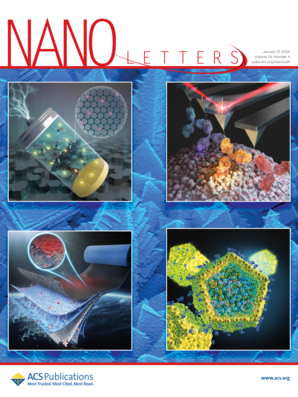Imaging the Thermal Dynamic Panorama for Volume Phase Transition and Water-Molecule Communication of Single Microhydrogels
IF 9.6
1区 材料科学
Q1 CHEMISTRY, MULTIDISCIPLINARY
引用次数: 0
Abstract
Thermal volume phase transition of thermosensitive hydrogels, the intrinsic stress-stimulated response of the microstructure, is widely utilized to fabricate flexible smart devices. However, their stability and responsiveness are limited by mechanical properties linked to size, water content, and polymer chain deformation. Herein, we employed a synchronous thermal–optical imaging technique to in situ investigate the volume phase transition behaviors of a single microhydrogel under thermal cycling. At the single-microhydrogel level, we found that hysteretic dynamics within the low critical solution temperature region revealed distinct collapse/swell mechanisms tied to water-molecule communication and microscale morphology. Furthermore, the hydrophilicity of a substrate regulates the microgel mobility, affecting water transport and intermicrogel communication. Additionally, microgel water-molecule communication enables infiltration on superhydrophobic surfaces like lotus leaves. This thermal-controlled optical imaging methodology greatly develops a serviceable characterization of flexible stimuli-driven materials and devices at the microentity level, decoding their detailed dynamic processes, transient intermediate states, and intrinsic mechanisms.

单个微水凝胶体积相变和水分子通讯的热动力学全景成像
热敏水凝胶的热体积相变是其微观结构的本征应力响应,被广泛应用于柔性智能器件的制造。然而,它们的稳定性和响应性受到与尺寸、含水量和聚合物链变形相关的机械性能的限制。本文采用同步热光学成像技术原位研究了单个微水凝胶在热循环下的体积相变行为。在单微水凝胶水平上,我们发现在低临界溶液温度区域内的滞后动力学揭示了与水分子通信和微尺度形态相关的独特的坍塌/膨胀机制。此外,底物的亲水性调节了微凝胶的流动性,影响了水的输送和微凝胶间的通讯。此外,微凝胶水分子通信可以渗透到像荷叶这样的超疏水表面。这种热控光学成像方法在微观层面上极大地发展了柔性刺激驱动材料和器件的可用表征,解码了它们的详细动态过程、瞬态中间状态和内在机制。
本文章由计算机程序翻译,如有差异,请以英文原文为准。
求助全文
约1分钟内获得全文
求助全文
来源期刊

Nano Letters
工程技术-材料科学:综合
CiteScore
16.80
自引率
2.80%
发文量
1182
审稿时长
1.4 months
期刊介绍:
Nano Letters serves as a dynamic platform for promptly disseminating original results in fundamental, applied, and emerging research across all facets of nanoscience and nanotechnology. A pivotal criterion for inclusion within Nano Letters is the convergence of at least two different areas or disciplines, ensuring a rich interdisciplinary scope. The journal is dedicated to fostering exploration in diverse areas, including:
- Experimental and theoretical findings on physical, chemical, and biological phenomena at the nanoscale
- Synthesis, characterization, and processing of organic, inorganic, polymer, and hybrid nanomaterials through physical, chemical, and biological methodologies
- Modeling and simulation of synthetic, assembly, and interaction processes
- Realization of integrated nanostructures and nano-engineered devices exhibiting advanced performance
- Applications of nanoscale materials in living and environmental systems
Nano Letters is committed to advancing and showcasing groundbreaking research that intersects various domains, fostering innovation and collaboration in the ever-evolving field of nanoscience and nanotechnology.
 求助内容:
求助内容: 应助结果提醒方式:
应助结果提醒方式:


